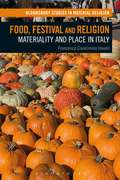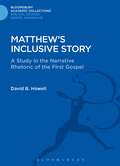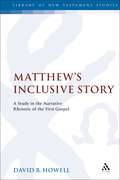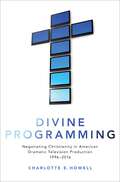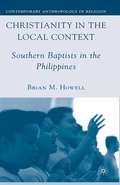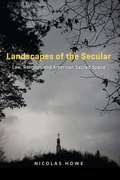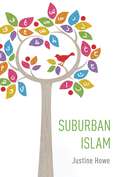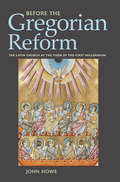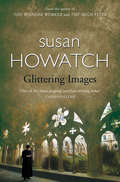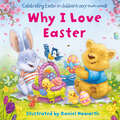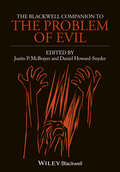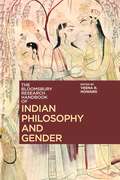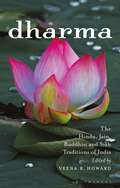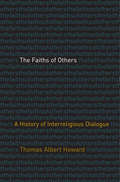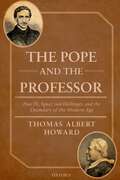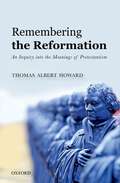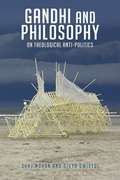- Table View
- List View
Food, Festival and Religion: Materiality and Place in Italy (Bloomsbury Studies in Material Religion)
by Francesca Ciancimino HowellFood, Festival and Religion explores how communities in northern Italy find a restorative sense of place through foodways, costuming and other forms of materiality. Festivals examined by the author vary geographically from the northern rural corners of Italy to the fashionable heart of urban Milan. The origins of these lived religious events range from Christian to vernacular Italian witchcraft and contemporary Paganism, which is rapidly growing in Italy. Francesca Ciancimino Howell demonstrates that during ritualized occasions the sacred is located within the mundane. She argues that communal feasting, pilgrimage, rituals and costumed events can represent forms of lived religious materiality. Building on the work of scholars including Foucault, Grimes and Ingold, Howell offers a theoretical “Scale of Engagement” which further tests the interfaces between and among the materialities of place, food, ritual and festivals and provides a widely-applicable model for analyzing grassroots events and community initiatives.Through extensive ethnographic research and fieldwork data, this book demonstrates that popular Italian festivals can be ritualized, liminal spaces, contributing greatly to the fields of religious, performance and ritual studies.
Matthew's Inclusive Story: A Study in the Narrative Rhetoric of the First Gospel (The Library of New Testament Studies)
by David B. HowellMatthew has been described as an 'inclusive story', in which the experiences of the evangelist's post-Easter church are inscribed in the story of Jesus's earthly ministry. This book explores the inclusive nature of the Gospel by means of reader-response literary criticism. Some recent redaction studies of Matthew are reviewed from the perspective of reader-response criticism. Then, in an attempt to understand the interpretative moves readers make, Matthew's story, story-teller and audience are examined.
Matthew's Inclusive Story: A Study in the Narrative Rhetoric of the First Gospel (The Library of New Testament Studies #42)
by David B. HowellMatthew has been described as an 'inclusive story', in which the experiences of the evangelist's post-Easter church are inscribed in the story of Jesus' earthly ministry. This book explores the inclusive nature of the Gospel by means of reader-response literary criticism. Some recent redaction studies of Matthew are reviewed from the perspective of reader-response criticism. Then, in an attempt to understand the interpretative moves readers make, Matthew's story, story-teller and audience are examined.
Divine Programming: Negotiating Christianity in American Dramatic Television Production 1996-2016
by Charlotte E. HowellFrom the mid-90s to the present, television drama with religious content has come to reflect the growing cultural divide between white middle-America and concentrated urban elites. As author Charlotte E. Howell argues in this book, by 2016, television narratives of white Christianity had become entirely disconnected from the religion they were meant to represent. Programming labeled 'family-friendly' became a euphemism for white, middlebrow America, and developing audience niches became increasingly significant to serial dramatic television. Utilizing original case studies and interviews, Divine Programming investigates the development, writing, producing, marketing, and positioning of key series including 7th Heaven, Friday Night Lights, Rectify, Supernatural, Jane the Virgin, Daredevil, and Preacher. As this book shows, there has historically been a deep ambivalence among television production cultures regarding religion and Christianity more specifically. It illustrates how middle-American television audiences lost significance within the Hollywood television industry and how this in turn has informed and continues to inform television programming on a larger scale. In recent years, upscale audience niches have aligned with the perceived tastes of affluent, educated, multicultural, and-importantly-secular elites. As a result, the televised representation of white Christianity had to be othered, and shifted into the unreality of fantastic genres to appeal to niche audiences. To examine this effect, Howell looks at religious representation through four approaches - establishment, distancing, displacement, and use - and looks at series across a variety of genres and outlets in order to provied varied analyses of each theme.
DIVINE PROGRAMMING C: Negotiating Christianity in American Dramatic Television Production 1996-2016
by Charlotte E. HowellFrom the mid-90s to the present, television drama with religious content has come to reflect the growing cultural divide between white middle-America and concentrated urban elites. As author Charlotte E. Howell argues in this book, by 2016, television narratives of white Christianity had become entirely disconnected from the religion they were meant to represent. Programming labeled 'family-friendly' became a euphemism for white, middlebrow America, and developing audience niches became increasingly significant to serial dramatic television. Utilizing original case studies and interviews, Divine Programming investigates the development, writing, producing, marketing, and positioning of key series including 7th Heaven, Friday Night Lights, Rectify, Supernatural, Jane the Virgin, Daredevil, and Preacher. As this book shows, there has historically been a deep ambivalence among television production cultures regarding religion and Christianity more specifically. It illustrates how middle-American television audiences lost significance within the Hollywood television industry and how this in turn has informed and continues to inform television programming on a larger scale. In recent years, upscale audience niches have aligned with the perceived tastes of affluent, educated, multicultural, and-importantly-secular elites. As a result, the televised representation of white Christianity had to be othered, and shifted into the unreality of fantastic genres to appeal to niche audiences. To examine this effect, Howell looks at religious representation through four approaches - establishment, distancing, displacement, and use - and looks at series across a variety of genres and outlets in order to provied varied analyses of each theme.
Christianity in the Local Context: Southern Baptists in the Philippines (Contemporary Anthropology of Religion)
by B. HowellIn three congregations, representing three distinct social locations, Howell goes beneath the surface to argue that even with these Western forms, these Filipino Baptists are actively constructing themselves and the locality itself in terms of this global faith they have made their own.
Landscapes of the Secular: Law, Religion, and American Sacred Space
by Nicolas Howe“What does it mean to see the American landscape in a secular way?” asks Nicolas Howe at the outset of this innovative, ambitious, and wide-ranging book. It’s a surprising question because of what it implies: we usually aren’t seeing American landscapes through a non-religious lens, but rather as inflected by complicated, little-examined concepts of the sacred. Fusing geography, legal scholarship, and religion in a potent analysis, Howe shows how seemingly routine questions about how to look at a sunrise or a plateau or how to assess what a mountain is both physically and ideologically, lead to complex arguments about the nature of religious experience and its implications for our lives as citizens. In American society—nominally secular but committed to permitting a diversity of religious beliefs and expressions—such questions become all the more fraught and can lead to difficult, often unsatisfying compromises regarding how to interpret and inhabit our public lands and spaces. A serious commitment to secularism, Howe shows, forces us to confront the profound challenges of true religious diversity in ways that often will have their ultimate expression in our built environment. This provocative exploration of some of the fundamental aspects of American life will help us see the land, law, and society anew.
Landscapes of the Secular: Law, Religion, and American Sacred Space
by Nicolas Howe“What does it mean to see the American landscape in a secular way?” asks Nicolas Howe at the outset of this innovative, ambitious, and wide-ranging book. It’s a surprising question because of what it implies: we usually aren’t seeing American landscapes through a non-religious lens, but rather as inflected by complicated, little-examined concepts of the sacred. Fusing geography, legal scholarship, and religion in a potent analysis, Howe shows how seemingly routine questions about how to look at a sunrise or a plateau or how to assess what a mountain is both physically and ideologically, lead to complex arguments about the nature of religious experience and its implications for our lives as citizens. In American society—nominally secular but committed to permitting a diversity of religious beliefs and expressions—such questions become all the more fraught and can lead to difficult, often unsatisfying compromises regarding how to interpret and inhabit our public lands and spaces. A serious commitment to secularism, Howe shows, forces us to confront the profound challenges of true religious diversity in ways that often will have their ultimate expression in our built environment. This provocative exploration of some of the fundamental aspects of American life will help us see the land, law, and society anew.
Landscapes of the Secular: Law, Religion, and American Sacred Space
by Nicolas Howe“What does it mean to see the American landscape in a secular way?” asks Nicolas Howe at the outset of this innovative, ambitious, and wide-ranging book. It’s a surprising question because of what it implies: we usually aren’t seeing American landscapes through a non-religious lens, but rather as inflected by complicated, little-examined concepts of the sacred. Fusing geography, legal scholarship, and religion in a potent analysis, Howe shows how seemingly routine questions about how to look at a sunrise or a plateau or how to assess what a mountain is both physically and ideologically, lead to complex arguments about the nature of religious experience and its implications for our lives as citizens. In American society—nominally secular but committed to permitting a diversity of religious beliefs and expressions—such questions become all the more fraught and can lead to difficult, often unsatisfying compromises regarding how to interpret and inhabit our public lands and spaces. A serious commitment to secularism, Howe shows, forces us to confront the profound challenges of true religious diversity in ways that often will have their ultimate expression in our built environment. This provocative exploration of some of the fundamental aspects of American life will help us see the land, law, and society anew.
Landscapes of the Secular: Law, Religion, and American Sacred Space
by Nicolas Howe“What does it mean to see the American landscape in a secular way?” asks Nicolas Howe at the outset of this innovative, ambitious, and wide-ranging book. It’s a surprising question because of what it implies: we usually aren’t seeing American landscapes through a non-religious lens, but rather as inflected by complicated, little-examined concepts of the sacred. Fusing geography, legal scholarship, and religion in a potent analysis, Howe shows how seemingly routine questions about how to look at a sunrise or a plateau or how to assess what a mountain is both physically and ideologically, lead to complex arguments about the nature of religious experience and its implications for our lives as citizens. In American society—nominally secular but committed to permitting a diversity of religious beliefs and expressions—such questions become all the more fraught and can lead to difficult, often unsatisfying compromises regarding how to interpret and inhabit our public lands and spaces. A serious commitment to secularism, Howe shows, forces us to confront the profound challenges of true religious diversity in ways that often will have their ultimate expression in our built environment. This provocative exploration of some of the fundamental aspects of American life will help us see the land, law, and society anew.
Suburban Islam
by Justine HoweFor many American Muslims, the 9/11 attacks and subsequent War on Terror marked a rise in intense scrutiny of their religious lives and political loyalties. In Suburban Islam, Justine Howe explores the rise of "third spaces," social surroundings that are neither home nor work, created by educated, middle-class American Muslims in the wake of increased marginalization. Third spaces provide them the context to challenge their exclusion from the American mainstream and to enact visions for American Islam different from those they encounter in their local mosques. One such third space is the Mohammed Alexander Russell Webb Foundation, a family-oriented Muslim institution in Chicago's suburbs. Howe uses Webb as a window into how Muslim American identity is formed through the interplay of communal interpretive practices, institutional rituals, and everyday life. The diverse Muslim families of the Webb Foundation have transformed hallmark secular suburbanite activities like football games, apple picking, and camping trips into acts of piety--rituals they describe as the enactment of "proper" American Muslim identity. Howe analyzes the relationship between these consumerist practices and the Webb Foundation's adult educational programs, through which participants critique what they call "cultural Islam." They envision creating an "indigenous" American Islam characterized by gender equality, reason, and pluralism. Through changing configurations of ethnicity, gender, and socioeconomic class, Webb participants imagine a "seamless identity" that marries their Muslim faith to an idealized vision of suburban middle-class America. Suburban Islam captures the fragile optimism of educated, cosmopolitan American Muslims during the Obama presidency, as they imagined a post-racial, pluralistic, and culturally resonant American Islam. Even as this vision aims to be more inclusive, it also reflects enduring inequalities of race, class, and gender.
Suburban Islam
by Justine HoweFor many American Muslims, the 9/11 attacks and subsequent War on Terror marked a rise in intense scrutiny of their religious lives and political loyalties. In Suburban Islam, Justine Howe explores the rise of "third spaces," social surroundings that are neither home nor work, created by educated, middle-class American Muslims in the wake of increased marginalization. Third spaces provide them the context to challenge their exclusion from the American mainstream and to enact visions for American Islam different from those they encounter in their local mosques. One such third space is the Mohammed Alexander Russell Webb Foundation, a family-oriented Muslim institution in Chicago's suburbs. Howe uses Webb as a window into how Muslim American identity is formed through the interplay of communal interpretive practices, institutional rituals, and everyday life. The diverse Muslim families of the Webb Foundation have transformed hallmark secular suburbanite activities like football games, apple picking, and camping trips into acts of piety--rituals they describe as the enactment of "proper" American Muslim identity. Howe analyzes the relationship between these consumerist practices and the Webb Foundation's adult educational programs, through which participants critique what they call "cultural Islam." They envision creating an "indigenous" American Islam characterized by gender equality, reason, and pluralism. Through changing configurations of ethnicity, gender, and socioeconomic class, Webb participants imagine a "seamless identity" that marries their Muslim faith to an idealized vision of suburban middle-class America. Suburban Islam captures the fragile optimism of educated, cosmopolitan American Muslims during the Obama presidency, as they imagined a post-racial, pluralistic, and culturally resonant American Islam. Even as this vision aims to be more inclusive, it also reflects enduring inequalities of race, class, and gender.
Before the Gregorian Reform: The Latin Church at the Turn of the First Millennium
by John HoweHistorians typically single out the hundred-year period from about 1050 to 1150 as the pivotal moment in the history of the Latin Church, for it was then that the Gregorian Reform movement established the ecclesiastical structure that would ensure Rome’s dominance throughout the Middle Ages and beyond. In Before the Gregorian Reform John Howe challenges this familiar narrative by examining earlier, "pre-Gregorian" reform efforts within the Church. He finds that they were more extensive and widespread than previously thought and that they actually established a foundation for the subsequent Gregorian Reform movement.The low point in the history of Christendom came in the late ninth and early tenth centuries—a period when much of Europe was overwhelmed by barbarian raids and widespread civil disorder, which left the Church in a state of disarray. As Howe shows, however, the destruction gave rise to creativity. Aristocrats and churchmen rebuilt churches and constructed new ones, competing against each other so that church building, like castle building, acquired its own momentum. Patrons strove to improve ecclesiastical furnishings, liturgy, and spirituality. Schools were constructed to staff the new churches. Moreover, Howe shows that these reform efforts paralleled broader economic, social, and cultural trends in Western Europe including the revival of long-distance trade, the rise of technology, and the emergence of feudal lordship. The result was that by the mid-eleventh century a wealthy, unified, better-organized, better-educated, more spiritually sensitive Latin Church was assuming a leading place in the broader Christian world. Before the Gregorian Reform challenges us to rethink the history of the Church and its place in the broader narrative of European history. Compellingly written and generously illustrated, it is a book for all medievalists as well as general readers interested in the Middle Ages and Church history.
Glittering Images: A Novel (Starbridge Ser. #1)
by Susan HowatchThe author’s most famous and well-loved work, the Starbridge series, six self-contained yet interconnected novels that explore the history of the Church of England through the 20th century.
Why I Love Easter
by Daniel HowarthFeaturing children’s own words and heart-warming pictures, this board book is a perfect celebration of everything there is to love about Easter!
The Blackwell Companion to The Problem of Evil
by Daniel Howard-Snyder Justin P. McBrayerThe Blackwell Companion to the Problem of Evil presents a collection of original essays providing both overview and insight, clarifying and evaluating the philosophical and theological “problem of evil” in its various contexts and manifestations. Features all original essays that explore the various forms of the problems of evil, offering theistic responses that attempt to explain evil as well as discussion of the challenges facing such explanations Includes section introductions with a historical essay that traces the developments of the issues explored Acknowledges the fact that there are many problems of evil, some of which apply only to those who believe in concepts such as hell and some of which apply to non-theists Represents views from the various religious traditions, including Hindu, Jewish, Christian, and Muslim
The Bloomsbury Research Handbook of Indian Philosophy and Gender (Bloomsbury Research Handbooks in Asian Philosophy)
by Veena R. Howard'How do gender constructions transform religious experiences?' 'What is the role of bodily materiality in ethics and epistemology?' 'How does rethinking gender and sexuality force us to reconceptualise settled ontological frameworks?' This collection provides the first research resource to Indian philosophical gender issues, exploring a variety of texts and traditions from Indian philosophy where the treatment of gender is dynamic and diverse.Organised around three central themes - the gender dynamics of enlightenment in the Hindu and Buddhist traditions; the simple binary opposition of genders in Indian traditions; the ways in which symbolic representations of gender differ from social realities in Hindu and Buddhist practice – a team of respected scholars discuss feminist readings, examinations of femininity and masculinity, as well as queer and trans identities, representations, and theories. Beginning with the Vedic tradition and ending with sections on Sri Ramakrishna and Gandhi, this wide-ranging handbook encourages fresh inquiry into classic philosophical questions. Offering critical analyses relevant to literary, cultural and religious studies, The Bloomsbury Research Handbook of Indian Philosophy and Gender opens up new ways of understanding gender and South Asian philosophy.
Dharma: The Hindu, Jain, Buddhist and Sikh Traditions of India (Library of Modern Religion)
by Veena R. HowardDharma is central to all the major religious traditions which originated on the Indian subcontinent. Such is its importance that these traditions cannot adequately be understood apart from it. Often translated as “ethics,” “religion,” “law,” or “social order,” dharma possesses elements of each of these but is not confined to any single category familiar to Western thought. Neither is it the straightforward equivalent of what many in the West might usually consider to be “a philosophy”. This much-needed analysis of the history and heritage of dharma shows that it is instead a multi-faceted religious force, or paradigm, that has defined and that continues to shape the different cultures and civilizations of South Asia in a whole multitude of forms, organizing many aspects of life. Experts in the fields of Hindu, Jain, Buddhist and Sikh studies here bring fresh insights to dharma in terms both of its distinctiveness and its commonality as these are expressed across, and between, the several religions of the subcontinent. Exploring ethics, practice, history and social and gender issues, the contributors engage critically with some prevalent and often problematic interpretations of dharma, and point to new ways of appreciating these traditions in a manner that is appropriate to and thoroughly consistent with their varied internal debates, practices and self-representations.
The Bloomsbury Research Handbook of Indian Philosophy and Gender (Bloomsbury Research Handbooks in Asian Philosophy)
by Veena Howard'How do gender constructions transform religious experiences?' 'What is the role of bodily materiality in ethics and epistemology?' 'How does rethinking gender and sexuality force us to reconceptualise settled ontological frameworks?' This collection provides the first research resource to Indian philosophical gender issues, exploring a variety of texts and traditions from Indian philosophy where the treatment of gender is dynamic and diverse.Organised around three central themes - the gender dynamics of enlightenment in the Hindu and Buddhist traditions; the simple binary opposition of genders in Indian traditions; the ways in which symbolic representations of gender differ from social realities in Hindu and Buddhist practice – a team of respected scholars discuss feminist readings, examinations of femininity and masculinity, as well as queer and trans identities, representations, and theories. Beginning with the Vedic tradition and ending with sections on Sri Ramakrishna and Gandhi, this wide-ranging handbook encourages fresh inquiry into classic philosophical questions. Offering critical analyses relevant to literary, cultural and religious studies, The Bloomsbury Research Handbook of Indian Philosophy and Gender opens up new ways of understanding gender and South Asian philosophy.
The Faiths of Others: A History of Interreligious Dialogue
by Thomas Albert HowardThe first intellectual history of interreligious dialogue, a relatively new and significant dimension of human religiosity In recent decades, organizations committed to interreligious or interfaith dialogue have proliferated, both in the Western and non†‘Western worlds. Why? How so? And what exactly is interreligious dialogue? These are the touchstone questions of this book, the first major history of interreligious dialogue in the modern age. Thomas Albert Howard narrates and analyzes several key turning points in the history of interfaith dialogue before examining, in the conclusion, the contemporary landscape. While many have theorized about and practiced interreligious dialogue, few have attended carefully to its past, connecting its emergence and spread with broader developments in modern history. Interreligious dialogue—grasped in light of careful, critical attention to its past—holds promise for helping people of diverse faith backgrounds to foster cooperation and knowledge of one another while contributing insight into contemporary, global religious pluralism.
The Pope and the Professor: Pius IX, Ignaz von Döllinger, and the Quandary of the Modern Age
by Thomas Albert HowardThe Pope and the Professor tells the captivating story of the German Catholic theologian and historian Ignaz von Döllinger (1799-1890), who fiercely opposed the teaching of Papal Infallibility at the time of the First Vatican Council (1869-70), convened by Pope Pius IX (r. 1846-1878), among the most controversial popes in the history of the papacy. Döllinger's thought, his opposition to the Council, his high-profile excommunication in 1871, and the international sensation that this action caused offer a fascinating window into the intellectual and religious history of the nineteenth century. Thomas Albert Howard examines Döllinger's post-conciliar activities, including pioneering work in ecumenism and inspiring the"Old Catholic" movement in Central Europe. Set against the backdrop of Italian and German national unification, and the rise of anticlericalism and ultramontanism after the French Revolution, The Pope and the Professor is at once an endeavor of historical and theological inquiry. It provides nuanced historical contextualization of the events, topics, and personalities, while also raising abiding questions about the often fraught relationship between individual conscience and scholarly credentials, on the one hand, and church authority and tradition, on the other.
The Pope and the Professor: Pius IX, Ignaz von Döllinger, and the Quandary of the Modern Age
by Thomas Albert HowardThe Pope and the Professor tells the captivating story of the German Catholic theologian and historian Ignaz von Döllinger (1799-1890), who fiercely opposed the teaching of Papal Infallibility at the time of the First Vatican Council (1869-70), convened by Pope Pius IX (r. 1846-1878), among the most controversial popes in the history of the papacy. Döllinger's thought, his opposition to the Council, his high-profile excommunication in 1871, and the international sensation that this action caused offer a fascinating window into the intellectual and religious history of the nineteenth century. Thomas Albert Howard examines Döllinger's post-conciliar activities, including pioneering work in ecumenism and inspiring the"Old Catholic" movement in Central Europe. Set against the backdrop of Italian and German national unification, and the rise of anticlericalism and ultramontanism after the French Revolution, The Pope and the Professor is at once an endeavor of historical and theological inquiry. It provides nuanced historical contextualization of the events, topics, and personalities, while also raising abiding questions about the often fraught relationship between individual conscience and scholarly credentials, on the one hand, and church authority and tradition, on the other.
Remembering the Reformation: An Inquiry into the Meanings of Protestantism
by Thomas Albert HowardThe 500th anniversary of the Reformation in 2017 focuses the mind on the history and significance of Protestant forms of Christianity. It also prompts the question of how the Reformation has been commemorated on past anniversary occasions. In an effort to examine various meanings attributed to Protestantism, this book recounts and analyzes major commemorative occasions, including the famous posting of the 95 Theses in 1517 or the birth and death dates of Martin Luther, respectively 1483 and 1546. Beginning with the first centennial jubilee in 1617, Remembering the Reformation: An Inquiry into the Meanings of Protestantism makes its way to the 500th anniversary of Martin Luther's birth, internationally marked in 1983. While the book focuses on German-speaking lands, Thomas Albert Howard also looks at Reformation commemorations in other countries, notably in the United States. The central argument is that past commemorations have been heavily shaped by their historical moment, exhibiting confessional, liberal, nationalist, militaristic, Marxist, and ecumenical motifs, among others.
Remembering the Reformation: An Inquiry into the Meanings of Protestantism
by Thomas Albert HowardThe 500th anniversary of the Reformation in 2017 focuses the mind on the history and significance of Protestant forms of Christianity. It also prompts the question of how the Reformation has been commemorated on past anniversary occasions. In an effort to examine various meanings attributed to Protestantism, this book recounts and analyzes major commemorative occasions, including the famous posting of the 95 Theses in 1517 or the birth and death dates of Martin Luther, respectively 1483 and 1546. Beginning with the first centennial jubilee in 1617, Remembering the Reformation: An Inquiry into the Meanings of Protestantism makes its way to the 500th anniversary of Martin Luther's birth, internationally marked in 1983. While the book focuses on German-speaking lands, Thomas Albert Howard also looks at Reformation commemorations in other countries, notably in the United States. The central argument is that past commemorations have been heavily shaped by their historical moment, exhibiting confessional, liberal, nationalist, militaristic, Marxist, and ecumenical motifs, among others.
Rise and Fall of the Nine O'Clock Service
by Roland HowardCovers the story of "The Nine O'Clock Service" in Sheffield which received heavy publicity in 1995, following the exposure of scandals and abuses at the hands of the leader, Chris Brain. This book follows the development of the church and draws comparisons with other alternative churches.
